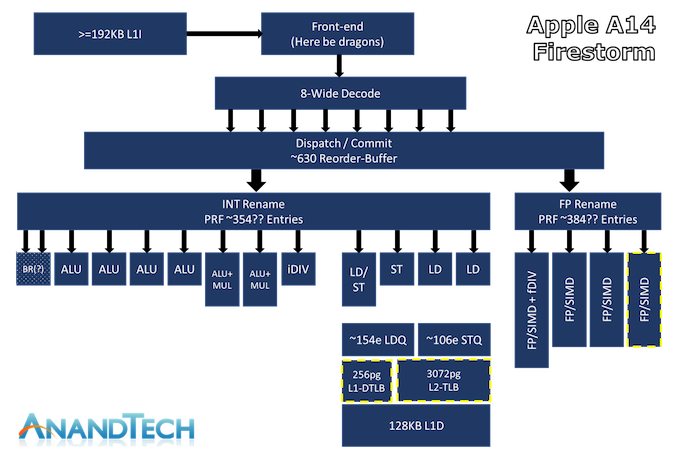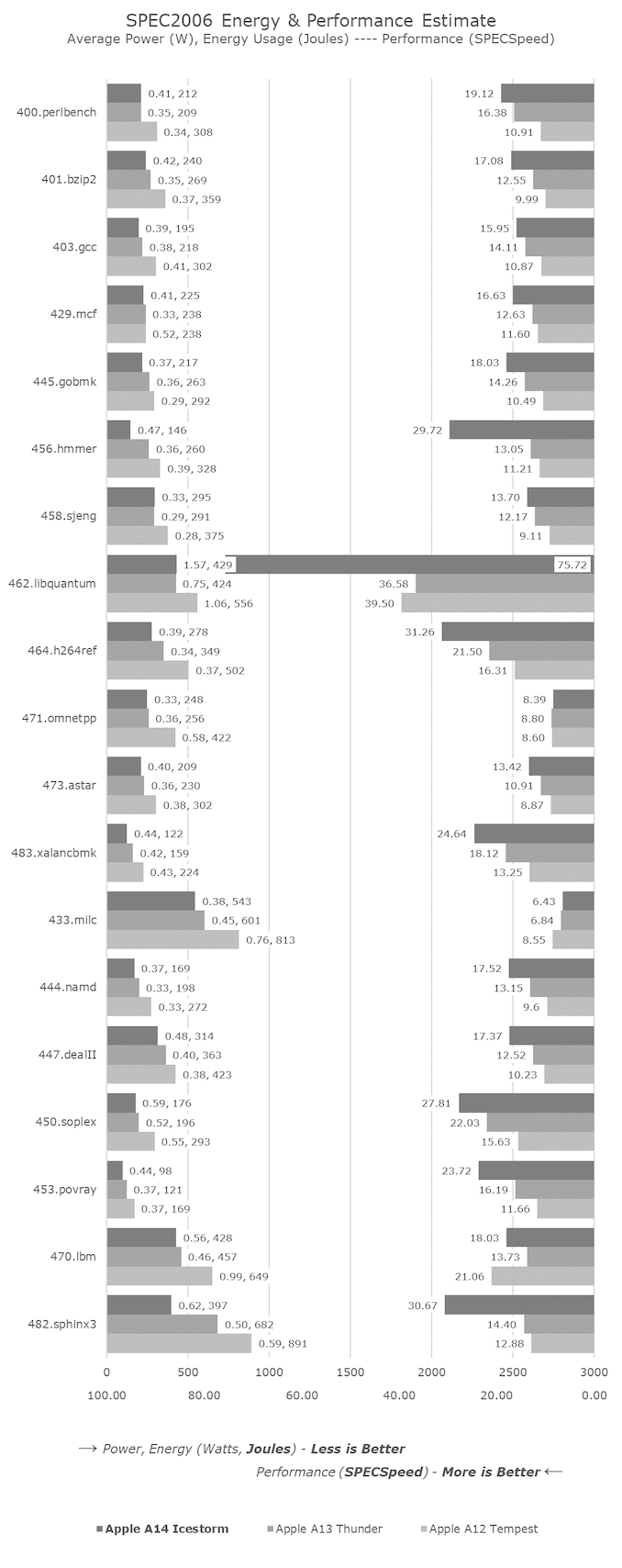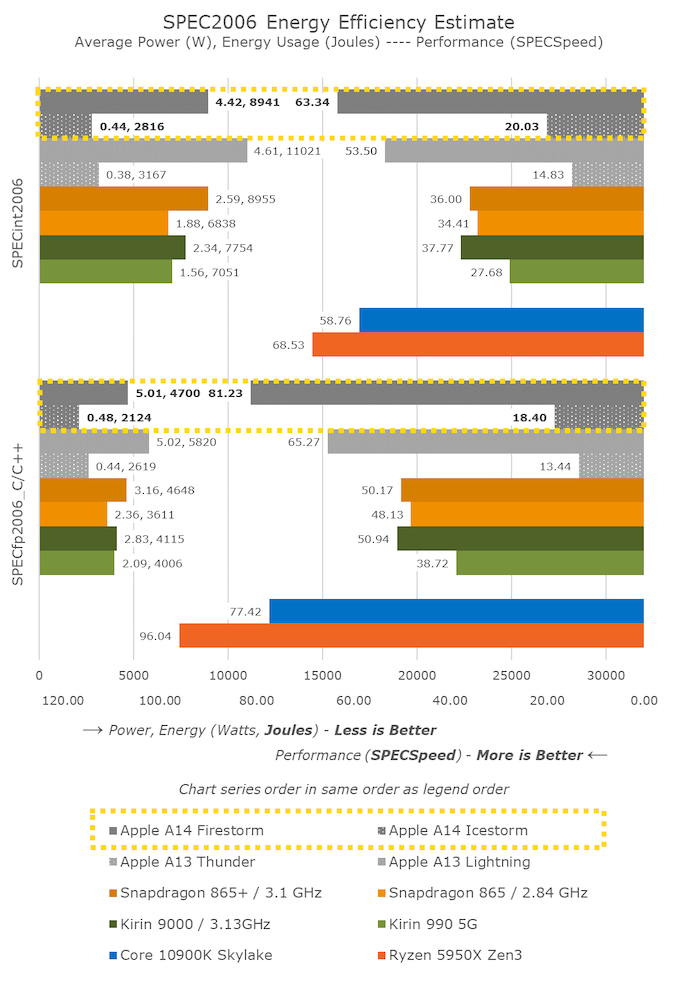The iPhone 12 & 12 Pro Review: New Design and Diminishing Returns
by Andrei Frumusanu on November 30, 2020 8:30 AM EST- Posted in
- Mobile
- Apple
- Smartphones
- Apple A14
- iPhone 12
- iPhone 12 Pro
The Apple A14 SoC: Firestorm & Icestorm
The new Apple A14 is the company’s newest mobile SoC and sits at the heart of the new iPhone 12 series. The new chip is the industry’s first commercial 5nm manufactured chip from TSMC, alongside the now no longer manufactured Kirin 9000.
Inside the A14 we find two big performance cores dubbed “Firestorm” and four efficiency cores called “Icestorm”, making this a 2+4 heterogeneous CPU SoC. Alongside the CPUs, we also find a 4-core GPU. Unfortunately this year it seems like we haven’t seen a public die shot of the A14, though Apple themselves published a shot of the M1 during their announcement event.
| Maximum Frequency vs Loaded Threads Per-Core Maximum MHz |
||||||
| Apple A13 | 1 | 2 | 3 | 4 | 5 | 6 |
| Performance 1 | 2666 | 2590 | 2590 | 2590 | 2590 | 2590 |
| Performance 2 | 2590 | 2590 | 2590 | 2590 | 2590 | |
| Efficiency 1 | 1728 | 1728 | 1728 | 1728 | ||
| Efficiency 2 | 1728 | 1728 | 1728 | |||
| Efficiency 3 | 1728 | 1728 | ||||
| Efficiency 4 | 1728 | |||||
| Apple A14 | 1 | 2 | 3 | 4 | 5 | 6 |
| Performance 1 | 2998 | 2890 | 2890 | 2890 | 2890 | 2890 |
| Performance 2 | 2890 | 2890 | 2890 | 2890 | 2890 | |
| Efficiency 1 | 1823 | 1823 | 1823 | 1823 | ||
| Efficiency 2 | 1823 | 1823 | 1823 | |||
| Efficiency 3 | 1823 | 1823 | ||||
| Efficiency 4 | 1823 | |||||
The new A14 raises the clock speeds of the CPU by a good amount, now essentially reaching 3GHz on the large performance cores in single-threaded scenarios. Once a second big cores come on this reduces to 2.89GHz and stays there even in heavier multi-threaded workloads. The efficiency cores land in at 1823MHz now, roughly a 100MHz boost over the A13, but we do know that in power unconstrained scenarios they can reach quite higher, such as 2064MHz employed on the M1.
The summary is that in this generation, Apple progresses the design further and making it wider than before, increasing the ROB size from 560 to 630, having significantly larger L1 DTLB which has now doubled in size from 128 pages to 256 pages, and increasing the L2 TLB from 2048 pages to 3072 pages. It’s particularly on the part of the floating point and vector execution units where the new Firestorm cores saw most of the design changes this year through the introduction of a 4th pipeline unit, essentially increasing the execution capabilities of this part of the design by 33%. On the integer side of the CPU, things have remained relatively the same with only minor changes, and the Firestorm cores continue on with the sale 192KB L1 I-cache and 128 L1 D-cache and 8MB of shared L2 amongst the two cores.
What we didn’t cover in more detail in the M1 piece was the new small efficiency cores. The Icestorm design is actually a quite major leap for Apple as it sees the introduction of a third integer ALU pipeline, and a full second FP/SIMD pipeline, vastly increasing the execution capabilities of this core. At this point it would be wrong to call it a “small” core anymore as it now essentially matches the big core designs from Arm from a few years ago, being similar in complexity as an A75.
Looking at the generational improvements of the efficiency cores we can see that Apple is indeed showcasing performance increases beyond that of just the increased 100MHz of the cores, with substantial upgrades across the workload spectrum.
Especially the floating-point workloads of the SPEC suite see very large improvements, exactly in the tests which are more execution heavy such as 453.povray or 482.sphinx3.
Apple still continues to limit the absolute performance of the efficiency cores when they are the only allowing the memory controller to not scale up to a higher frequency, meaning that the scores here in isolation are posting worse performance than in a normal more varied real-world scenario where the big CPU cores or the GPU would also be active, hence the scores aren’t directly comparable to other measurements we’ve made.
Overall, the new A14 is massively impressive and grows the performance gap compared to the competition. Apple has now reached higher single-threaded performance within their phone SoCs than what Intel can deliver in any of their designs, whilst only losing out to the desktop variants of AMD’s new Zen3 processors.
What’s important to note here is that Apple’s performance increase this generation did not come at a cost of increased power consumption, as the designers were able to leverage the microarchitectural improvements and the new process node – actually reaching either power parity or a small power reduction compared to the 7nm based A13. This means that the performance increases this generation also results in an energy efficiency increase for the design, with the A14 using notably less energy to complete a workload.
I’ve included the efficiency cores in the chart here to showcase that they’re not weak at all. The performance showcased here roughly matches a 2.2GHz Cortex-A76 which is essentially 4x faster than the performance of any other mobile SoC today which relies on Cortex-A55 cores, all while using roughly the same amount of system power and having 3x the power efficiency.













101 Comments
View All Comments
mrvco - Monday, November 30, 2020 - link
It was a good run since the OG iPhone launched, but I seem to have lost all interest in replacing smart phones. I've been using an XS Max (~work phone) and an LG V40 (~personal phone) for two years now and I'm still perfectly satisfied with both devices. They both do what I ask of them with little fuss and there just haven't been any new features or phones that have generated more than a passing interest for me.Bob Todd - Monday, November 30, 2020 - link
As someone who would sometimes change phones more than once a year, I've been in a similar place. We are getting to the point of "good enough" performance. Faster is always better, but high end (and even midrange) SOCs are pretty good these days. My 2 year old phone has 8GB of RAM, 256GB of storage, and a nice large display.I do think this generation of iPhones is interesting for a few reasons though. The Mini doesn't even have a good analogue in the Android world, and I'm excited that premium smaller form factor phones are a thing again.
FunBunny2 - Monday, November 30, 2020 - link
"The Mini doesn't even have a good analogue in the Android world, and I'm excited that premium smaller form factor phones are a thing again."it depends on use case. for those who use a smartphone mostly as a phone, then these Godzilla handsets are contraindicated. OTOH, if the use case is mostly watching video on the run, then the Max and similar make the most sense. Steve clearly intended the former, Mr. Market gave him a full body enema by telling him to shove those teeny, tiny thingees.
KPOM - Monday, November 30, 2020 - link
My mother and sister both opted for the 12 mini since they got tired of big phones. I’m sure they aren’t alone.GC2:CS - Monday, November 30, 2020 - link
Well is there any reason why LPDDR5 was not used over the entire lineup (including M1) ? Is there some hidden compromise with LPDDR5 ?So if CPU is improved quite a bit in regards to efficiency, why the GPU lacks an update ? Is it possible that newer node benefits the CPU more than GPU ?
I heard about new Pro Oleds having better viewing angles. This is something i would greatly appreciate. 11´s Pro do have quite big shifts in white - at screen edges it has greenish, bluish cast. Can somebody describe it a but more ?
I think this generation could be better. But 5G is quite monumental increse in RF complexity and imagining they did it with custom antena designs and thinner designs is quite remarkable.
For exemple three mmWave antenas were discoverd so far. One on the side next to the battery, one behind the motherboard and one under the notch on the front.
But on the other hand 5G sucked up all the effort for other upgrades like better bigger cameras, batteries, 120 Hz and so on.
I refuse to believe that the next one is iPhone 13. That is just so unlucky...
michael2k - Monday, November 30, 2020 - link
I think you answered your own question. The focus on 5G took resources away from lpddr5.mmm200 - Monday, November 30, 2020 - link
I had both X and Xs Max, wife has 11 Pro.I could tell you how good the new 12 Pro Max display is.
It is better than Apple MBP16 in both color and brightness stability! 2 weeks in I'm amazed still how good the Pro display is!
Don't like the oversaturated images made indoor. Just too much vibrance and saturation. Looks unnatural.
2.5x telephoto is great outdoors in sunny weather.
HDR video capture is mindblowing! Using 1080p30 and 1080p60 - looks great on LG OLED!
name99 - Monday, November 30, 2020 - link
It's quite possible that world LPDD5 production capacity was not yet large enough?My GUESS is that the memory controller can handle LPDD5, and the M1X machines will ship with it (and those will be in low enough volume that it's not an issue).
I was surprised that the M1 Macs did not, but presumably Apple concluded it made no engineering sense -- they are clearly fast enough as is, so why not hold something in reserve to make the M1X machines look even better when they ship?
vFunct - Monday, November 30, 2020 - link
Why do you do camera tests without a SINGLE shot of a human being? You know, because how everyone uses phone cameras to take pictures of people at parties and other social events?Are you unable to find anyone willing to have photos taken?
michael2k - Monday, November 30, 2020 - link
Taking pictures of people aren't actually important for the test scenarios:Daylight evaluation is measuring the sensor and software in their ability to balance contrast, dynamic range, shadows, details, and color (and of course there were some people in those pictures)
Low light evaluation is evaluating how well the software can enhance the image without sacrificing color information, creating unusual color casts, capturing details, and balancing the light and darker portions of the pictures.
What you seem to be asking for is a review of https://www.anandtech.com/show/14892/the-apple-iph...">Portrait Mode? The 2018 https://www.anandtech.com/show/13392/the-iphone-xs...">Portrait Mode review was similarly brief (both less than 5 paragraphs!)